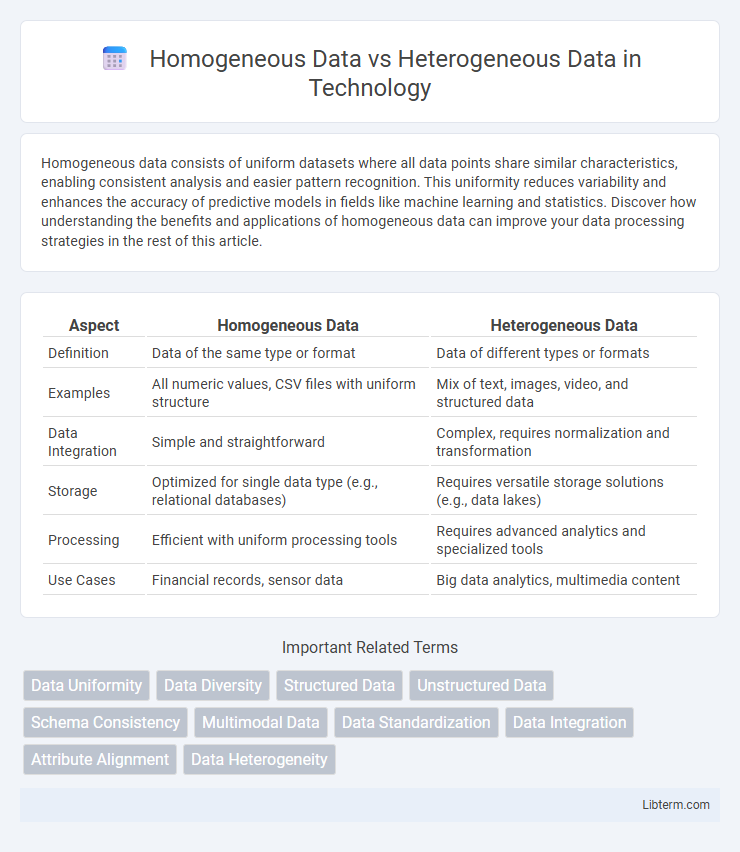Homogeneous data consists of uniform datasets where all data points share similar characteristics, enabling consistent analysis and easier pattern recognition. This uniformity reduces variability and enhances the accuracy of predictive models in fields like machine learning and statistics. Discover how understanding the benefits and applications of homogeneous data can improve your data processing strategies in the rest of this article.
Table of Comparison
| Aspect | Homogeneous Data | Heterogeneous Data |
|---|---|---|
| Definition | Data of the same type or format | Data of different types or formats |
| Examples | All numeric values, CSV files with uniform structure | Mix of text, images, video, and structured data |
| Data Integration | Simple and straightforward | Complex, requires normalization and transformation |
| Storage | Optimized for single data type (e.g., relational databases) | Requires versatile storage solutions (e.g., data lakes) |
| Processing | Efficient with uniform processing tools | Requires advanced analytics and specialized tools |
| Use Cases | Financial records, sensor data | Big data analytics, multimedia content |
Introduction to Data Types
Homogeneous data consists of elements that are all of the same data type, such as integers, strings, or floats, ensuring consistency in data processing tasks. In contrast, heterogeneous data contains elements of multiple data types, enabling more complex and diverse information representation within a single dataset or structure. Understanding the distinction between homogeneous and heterogeneous data types is crucial for effective data storage, manipulation, and algorithm design in computer science and data management.
Defining Homogeneous Data
Homogeneous data refers to datasets where all data points share the same type or structure, such as numerical values in a single column or text entries in a database field. This uniformity simplifies data processing, analysis, and integration because consistent formats reduce complexity and improve compatibility with algorithms. Examples of homogeneous data include sensor readings from identical devices or standardized survey responses, facilitating efficient statistical analysis and machine learning tasks.
What is Heterogeneous Data?
Heterogeneous data refers to datasets composed of diverse types and formats, including structured, semi-structured, and unstructured data from multiple sources such as text, images, videos, and sensor data. This diversity creates challenges in data integration, processing, and analysis due to varying schemas, formats, and semantic meanings. Efficient management of heterogeneous data requires advanced techniques like data fusion, schema matching, and machine learning to enable comprehensive insights across disparate data environments.
Key Differences Between Homogeneous and Heterogeneous Data
Homogeneous data consists of uniform types or formats, ensuring consistency across datasets, while heterogeneous data involves diverse types, structures, or sources, leading to complexity in integration and analysis. Homogeneous data facilitates simpler processing and analysis due to its standardized nature, whereas heterogeneous data requires advanced tools and techniques like data transformation and schema matching to achieve compatibility. Key differences include data uniformity, ease of management, and integration complexity, impacting data quality and analytical outcomes.
Examples of Homogeneous Data
Homogeneous data consists of elements that share the same data type or structure, such as a list of integers like [2, 4, 6, 8], or a database column containing only dates. Common examples include arrays of floating-point numbers used in scientific computations and CSV files where each column contains uniform data types like strings or numbers. These consistent data types facilitate efficient processing and analysis in programming and data science applications.
Examples of Heterogeneous Data
Heterogeneous data comprises diverse types and sources, such as structured data from relational databases, unstructured text documents, images, videos, and sensor data from IoT devices. Examples include a healthcare system combining patient records, medical imaging, and real-time wearable sensor readings, or an e-commerce platform integrating customer profiles, transaction logs, product reviews, and social media feeds. This variety poses unique challenges for data integration, storage, and analysis, requiring advanced techniques like data fusion and multimodal machine learning.
Advantages of Homogeneous Data
Homogeneous data offers enhanced consistency and ease of integration, as data originates from similar sources with uniform structure and format. This uniformity simplifies preprocessing, reduces errors, and boosts the accuracy of machine learning models and analytical processes. Organizations benefit from faster data processing and streamlined data management when working with homogeneous datasets.
Benefits of Heterogeneous Data
Heterogeneous data integrates diverse data types and sources, enhancing analytical depth and providing a comprehensive view of complex phenomena. This diversity improves machine learning model performance by enabling better generalization and robustness across different scenarios. Leveraging heterogeneous data facilitates more accurate decision-making and drives innovation by uncovering hidden patterns that homogeneous data alone might miss.
Choosing the Right Data Type for Your Application
Selecting the right data type depends on the nature of your application's data needs, with homogeneous data offering uniformity and ease of processing for structured datasets like arrays or tables. Heterogeneous data supports diverse data types within a single dataset, making it ideal for applications requiring flexibility, such as databases or data integration tasks. Understanding the trade-offs in data consistency, processing complexity, and storage optimization is crucial to ensure efficient data handling and system performance.
Conclusion: Homogeneous vs Heterogeneous Data
Homogeneous data consists of uniform data types, enabling streamlined processing and consistent analysis within databases or datasets. Heterogeneous data integrates diverse data formats, such as text, images, and numerical values, requiring advanced techniques for effective fusion and interpretation. Choosing between homogeneous and heterogeneous data depends on the specific application needs, data complexity, and the desired analytical outcomes.
Homogeneous Data Infographic

 libterm.com
libterm.com